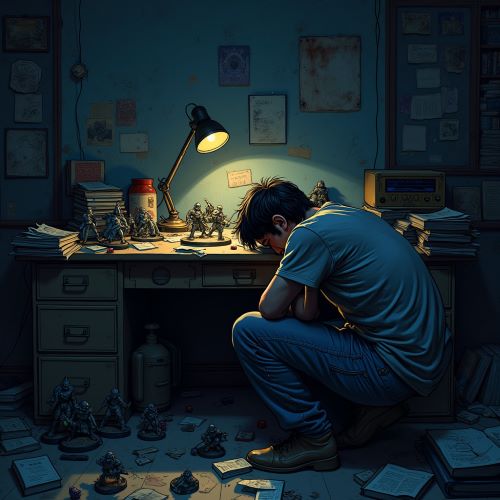I’ve written previously about the importance of improvisation, both at the gaming table and as a leader. However, improvisation can be intimidating in both cases. Yet, being able to think on your feet, adapt to unexpected changes, and make decisions in the moment is a vital skill that can boost your confidence and enhance your leadership abilities. This article covers practical tips for getting more comfortable with improvisation and explores how this skill benefits both D&D players and workplace leaders.
Why Improvisation Matters
In D&D, improvisation brings life to the game. A well-prepared Dungeon Master (DM) can set the stage, but it’s unplanned moments, like a character’s unexpected actions or a twist in the story, that make sessions really memorable. The ability to react, adapt, and roll with the punches is what keeps the game fluid and engaging.
Similarly, in the workplace, leaders face unplanned situations daily, from client feedback to team crises. Those who can adjust on the fly, make quick yet informed decisions, and guide their teams through uncertainty are more likely to succeed.
Practical Tips to Build Your Improvisation Skills
Here are some tips on how to improve your improv.
Embrace Mistakes
- In D&D: No DM has every possible outcome planned, and that’s okay. When players go off-script, don’t be afraid to make something up on the spot—even if it’s a little rough. Mistakes can lead to more interesting storytelling. For example, a misunderstood rule might create a new, fun dynamic in combat or a half formed NPC plucked from thin air can become a much loved party companion.
- In Leadership: Mistakes are learning opportunities. If you make a wrong call, own it, adjust quickly, and move on. Being comfortable with failure helps you improvise with less fear and hesitation.
Practice “Yes, and…”
- In D&D: Yes, and… is an improvisation staple. Instead of shutting down an unexpected idea, build on it. If a player says something wild, rather than saying “no, that can’t happen,” try saying “yes, and…” to take their idea and move it forward. For example, if a player decides to negotiate with a monster instead of fighting, roll with it and add complexity to the encounter.
- In Leadership: In meetings, say “yes, and” to ideas rather than shooting them down. Never dismiss things out of hand. Build on team members’ suggestions, fostering a more creative, solution-oriented environment.
Set Boundaries to Create Freedom
- In D&D: Some of the best improvisation happens within boundaries. Give yourself a loose structure—like a few key story beats or a clear understanding of the environment—so you have a framework to work within. This allows you to improvise while staying grounded.
- In Leadership: Having a clear vision or framework for your team gives you flexibility to adapt without losing sight of the overall goals. When improvising, it really helps to have a guiding principle to fall back on.
Start Small
- In D&D: Try improvising in low-stakes situations before doing it in major story arcs. Start with character interactions, minor NPCs, or side quests, where a misstep won’t have huge consequences.
- In Leadership: Begin by improvising during smaller meetings or in less formal conversations. Over time, this will help you build confidence for bigger moments, like client presentations or crisis management.
Prepare to Improvise
- In D&D: Ironically, preparation can make you a better improviser. When you know the world, characters, and plot beats inside and out, you’ll have more flexibility to pivot. Write down a few rough outlines of NPCs’ or Factions personalities or motivations. When things go off-script, you can lean on that prep work to improvise in a way that feels natural.
- In Leadership: In the workplace, preparation is key. Know your team, the project, and potential pitfalls ahead of time. This foreknowledge allows you to respond quickly and effectively when something doesn’t go according to plan. Be warned, improvising without preparation can lead to some pretty unpleasant outcomes.
Stay in the Moment
- In D&D: Being present with your players keeps the game moving and lets you respond to their cues. Listen actively, react to their energy, and don’t worry about the next scene or arc—just focus on the moment.
- In Leadership: In leadership, staying present helps you stay attuned to your team’s needs. Active listening allows you to catch important cues in meetings or conversations, which aids in quicker, more adaptive decision-making.
Use Prompts and Constraints
- In D&D: If you’re struggling to improvise, lean on prompts like dice rolls or random tables for inspiration. These can kick-start your creative process when your mind goes blank.
- In Leadership: In the workplace, use frameworks or decision-making tools to help structure your thinking when improvising. For example, asking yourself key questions (like “What’s our goal?” or “What resources do we have?”) can guide your decision-making.
The Benefits for D&D Players
Improvisation adds richness to the experience of playing D&D. As a DM, it creates organic moments of storytelling, while as a player, it enhances your ability to contribute meaningfully to the group dynamic. It also:
- Improves problem-solving skills: In a game where dice rolls and player choices can change the course of events, improvisation is essential for finding solutions to unexpected problems.
- Enhances creativity: The more you improvise, the more you’ll notice new ways to tackle challenges or interact with the story.
- Boosts confidence: Every time you improvise successfully, you build your self-assurance, making future off-the-cuff moments easier and more fun.

The Benefits for Leaders
For leaders, improvisation offers tangible workplace benefits:
- Adaptability: In today’s fast-changing business environment, leaders who can pivot when needed are invaluable. Improvisation teaches you to think quickly, assess the situation, and make decisions that keep the team moving forward.
- Problem-solving under pressure: Much like in D&D, leaders often have to deal with unexpected challenges. Being comfortable with improvisation helps you manage these situations without getting overwhelmed.
- Building team trust: A leader who is adaptable and open to creative solutions will foster an environment of trust and innovation. Team members will feel more comfortable bringing forward their ideas, knowing the leader can roll with the unexpected.
Improvisation Is a Skill Anyone Can Develop
Improvisation isn’t about being reckless or making things up for the sake of it. It’s about responding to the moment with confidence, creativity, and control. Whether you’re running a D&D game or leading a team at work, you can practice and refine this skill through small, intentional actions. The more you do it, the more natural it becomes—and the more effective you’ll be in both your roleplaying and leadership endeavors.
For more inspiration about improvisation check out this article from Forbes for leaders and this one from D&D Beyond for the gaming inspiration.



